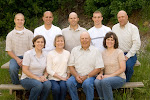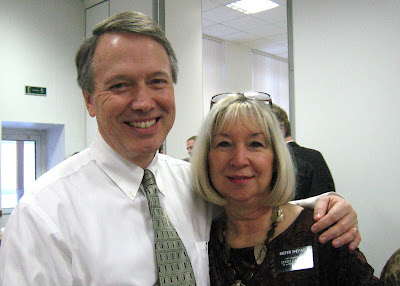We have been blessed to be able to share Moscow and the Russian culture with six of our seven children and their spouses. Scott & Kristine arrived Wednesday, March 20, via their visit in Switzerland. This was a day later than planned, since they missed their flight out of Zurich due to an accident in the tunnel that made them take a detour. By taking a sleeper train to Austria, they were able to fly from Vienna to Moscow and arrive a day later than originally planned. They still were able to see several of our favorite places in Moscow, the circus, and take a day trip to Sergiev Posad.
Scott & Kristine arrived in Moscow Wednesday afternoon (March 25). We never tire seeing Red Square especially at night when the lights give it an almost Disney Land look, so we took them there that first evening to see this famous icon of Russia. Jet lag didn't seem to be bothering them, and we went almost nonstop from then on.
Scott & Kristine arrived in Moscow Wednesday afternoon (March 25). We never tire seeing Red Square especially at night when the lights give it an almost Disney Land look, so we took them there that first evening to see this famous icon of Russia. Jet lag didn't seem to be bothering them, and we went almost nonstop from then on.
 St. Basil Cathedral in Red Square (Sam & Narene)
St. Basil Cathedral in Red Square (Sam & Narene) We did lots of walking. Here are the "twins"
We did lots of walking. Here are the "twins"(as Kristine referred to Scott and his dad),
leading the way with Kristine and I close behind.
By the way, Sam is on the left.
 Kristine with Novodevichy Convent and the
Kristine with Novodevichy Convent and theMoscow River in the background.
The Cathedral of Smolensk at Novodevichy Convent was built in 1524, and most of the other buildings were added in the late 17th century by Peter the Great's half sister, Regent Sophia. Peter had Sophia confined here for the rest of her life when he reclaimed his throne in 1689. After his death, Peter's first wife came to Novodevichy Convent from the convent in Suzdal where she had been confined by Peter the Great who did not like her. I read that since the convent had such famous nuns, it was very wealthy due to the donations of the Tsars and their families.
 The Cathedral of the Virgin of Smolensk
The Cathedral of the Virgin of Smolensk(Kristine, Narene, and Sam)
Many famous Russians are buried in Novodevichy Cemetery. Some were political or military leaders from the Soviet era. Others were known for their profession or arts. Most have prestigious headstones, often with a statue to memorialize the buried person.
 Scott & Kristine by one of the statues in
Scott & Kristine by one of the statues inNovodevichy Cemetery.
 Nikita Khrushchev, former Russian premier.
Nikita Khrushchev, former Russian premier. Kristine in front of Yeltsin's grave.
Kristine in front of Yeltsin's grave.His monument apparently represents the
red, blue, and white Russian flag.
The first time we came to Novodevichy, there was only a covered mound where Yeltsin is buried, the next time we came it was covered with a tent, and on our third visit we saw it with the monument as it is now.
 A military leader with his many medals.
A military leader with his many medals.On national holidays, the Russian war veterans like
to wear their medals, and they seem to have many.
All along the walls of the cemetery are small cubicles containing the ashes of those who were cremated, as seen in the photograph above. Many of these have pictures of the deceased. Some are children who died during World War II.
 Flowers are seen on some of the monuments.
Flowers are seen on some of the monuments.After our visit to Novodevichy, we went to Victory Park on Poklonnaya Gora, which is the hill where Napoleon waited for his troops to surround Moscow in 1812; but instead they were defeated. In 1834 an arch was built to commemorate the Russian victory over France, but it was moved to the present site in 1968.
 Grand Triumphal Arch
Grand Triumphal ArchCommemorating Napoleon's defeat in 1812.
 Victory Park
Victory Park150-meter high column topped with a statue of
Nike, the Goddess of Victory.
Victory Park was finished in time for the 50th anniversary of the end of the Great Patriotic War, which is what the Russians call World War II. Leading up to the tall column and the museum behind it are five terraces that symbolize the five years of the war (1941-1945); and there are 1,418 fountains (one for every day of the conflict). Of course, the fountains are turned off until warm weather arrives. We have been to the museum twice before, and it has impressive dioramas of the significant battles of the war; but on Thursdays it is closed, so we only saw the monuments outside on this visit with Scott & Kristine. One monument is in somber memory of the holocaust victims.
 A closer look at the tall column.
A closer look at the tall column. Escalator at the Park Pobedy metro station,
Escalator at the Park Pobedy metro station,reported to be the deepest in the world
(90 meters down).
The name means Victory Park in English.
(Scott is impressed with how deep it is.)
Scott & Kristine were also impressed with how
long the lines are at a McDonald's in Moscow.
 Russian officers in Red Square
Russian officers in Red Square
Sam and I have been inside the Cathedral of Christ the Redeemer and wanted to show it to Scott & Kristine, but it was closed.
 Cathedral of Christ the Redeemer,
Cathedral of Christ the Redeemer,
also known as Cathedral of Christ and Savior,
is the largest church in Russia. It holds
10,000 worshipers.
long the lines are at a McDonald's in Moscow.
 Russian officers in Red Square
Russian officers in Red SquareLeaving McDonald's, we went once again to Red Square. It was temporarily roped off while these officers were practicing maneuvers on horseback. A short while later, we were able to enter at a different entrance. We continued walking going across one of the several bridges across the Moscow River and saw the huge Peter the Great statue in the river.
Sam and I have been inside the Cathedral of Christ the Redeemer and wanted to show it to Scott & Kristine, but it was closed.
 Cathedral of Christ the Redeemer,
Cathedral of Christ the Redeemer,also known as Cathedral of Christ and Savior,
is the largest church in Russia. It holds
10,000 worshipers.
This is not the original building, which was completed in 1883 to celebrate the 1812 victory over Napoleon. Stalin had it destroyed in 1831 and planned to build a huge Palace of the Soviets on the land, but it was thought the land was too boggy. In the years that followed, the space was used for a year-round swimming pool among other things. In 1999, it was rebuilt mostly with private funds as a replica of the original. This time it took only four years to complete as compared to the 44 years it had taken for the original building.
This is called "Adult Vices." Each figure
represents a vice adults do that harms children.
It includes stealing, drugs, greed, gluttony, etc.
 Marriage Trees
Marriage Trees
On this bridge across the Moscow River,
brides and grooms lock their padlocks with their
names and wedding dates inscribed to signify
their eternal love. The "trees" are metal.
 Kristine & Scott by a Marriage Tree.
Kristine & Scott by a Marriage Tree.
 As we crossed the bridge, we saw this sunset
As we crossed the bridge, we saw this sunset
with one of the Seven Sisters silhouetted
in the distance.
Looking down on the rooftops of "Izmaly."
represents a vice adults do that harms children.
It includes stealing, drugs, greed, gluttony, etc.
 Marriage Trees
Marriage TreesOn this bridge across the Moscow River,
brides and grooms lock their padlocks with their
names and wedding dates inscribed to signify
their eternal love. The "trees" are metal.
I want to have a Marriage Tree in our yard in South Dakota where Sam and I and each of our children and their spouses will have a padlock and where our grandchildren will add theirs when they get married to symbolize our eternal love for each other. Our 50th wedding anniversary will be June 5, and I hope to have this in place when our family gets together to help us celebrate.
 Kristine & Scott by a Marriage Tree.
Kristine & Scott by a Marriage Tree. As we crossed the bridge, we saw this sunset
As we crossed the bridge, we saw this sunsetwith one of the Seven Sisters silhouetted
in the distance.
We ended the day by going to the circus, which I will write about in another blog. The next day, Friday, we took the electrishka train to Sergiev Posad; and I will have a separate blog for those pictures, too. Saturday morning, we went to Izmaly for souvenir shopping and to the Asian Market for that experience and ended the day by going to the Armory in the Kremlin.
Izmailovo or "Izmaly" is the largest souvenir
market in Moscow.
market in Moscow.
























































